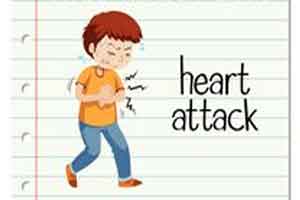- Home
- Editorial
- News
- Practice Guidelines
- Anesthesiology Guidelines
- Cancer Guidelines
- Cardiac Sciences Guidelines
- Critical Care Guidelines
- Dentistry Guidelines
- Dermatology Guidelines
- Diabetes and Endo Guidelines
- Diagnostics Guidelines
- ENT Guidelines
- Featured Practice Guidelines
- Gastroenterology Guidelines
- Geriatrics Guidelines
- Medicine Guidelines
- Nephrology Guidelines
- Neurosciences Guidelines
- Obs and Gynae Guidelines
- Ophthalmology Guidelines
- Orthopaedics Guidelines
- Paediatrics Guidelines
- Psychiatry Guidelines
- Pulmonology Guidelines
- Radiology Guidelines
- Surgery Guidelines
- Urology Guidelines
Nearly Half of All Heart Attacks May Be Silent

Dallas : Nearly half of all heart attacks may be silent and like those that cause chest pain or other warning signs, silent heart attacks increase the risk of dying from heart disease and other causes, according to new research in the American Heart Association’s journal Circulation.
A heart attack does not always have classic symptoms, such as pain in your chest, shortness of breath and cold sweats. In fact, a heart attack can occur without symptoms and it is called a silent heart attack (blood flow to the heart muscle is severely reduced or cut off completely).
“The outcome of a silent heart attack is as bad as a heart attack that is recognized while it is happening,” said Elsayed Z. Soliman, M.D., MSc., M.S., study senior author and director of the epidemiological cardiology research center at Wake Forest Baptist Medical Center, Winston-Salem, North Carolina. “And because patients don’t know they have had a silent heart attack, they may not receive the treatment they need to prevent another one.”
Researchers analyzed the records of 9,498 middle-age adults already enrolled in the Atherosclerosis Risk in Communities (ARIC), a study analyzing the causes and outcomes of atherosclerosis hardening of the arteries. Researchers examined heart attack differences between blacks and whites as well as men and women. Over an average of nine years after the start of the study, 317 participants had silent heart attacks while 386 had heart attacks with clinical symptoms. Researchers continued to follow participants for more than two decades to track deaths from heart attack and other diseases.
They found that silent heart attacks:
- made up 45 percent of all heart attacks;
- increased the chances of dying from heart disease by 3 times;
- increased the chances of dying from all causes by 34 percent; and
- were more common in men but more likely to cause death in women.
“Women with a silent heart attack appear to fare worse than men,” Soliman said. “Our study also suggests that blacks may fare worse than whites, but the number of blacks may have been too small to say that with certainty.”
Researchers accounted for many factors that could bias results, including smoking, body weight, diabetes, high blood pressure and cholesterol. They did not adjust for access to care but did adjust for income and education, which could impact access to care.
Symptoms of silent heart attacks appear so mild that they are barely noticed, if at all. They are detected later, usually when patients undergo an electrocardiogram, better known as an ECG or EKG, to check their heart’s electrical activity, researchers said.
Soliman said that silent heart attacks, once discovered, should be treated as aggressively as heart attacks with symptoms.
“The modifiable risk factors are the same for both kinds of heart attacks,” he said. “Doctors need to help patients who have had a silent heart attack quit smoking, reduce their weight, control cholesterol and blood pressure and get more exercise.”
In 1987, the ARIC Study began enrolling participants who were free of heart disease in four U.S. communities in Maryland, Minnesota, Mississippi and North Carolina to determine the risk factors for heart disease and health effects of hardening of the arteries over time.
First Author: Zhu-Ming Zhang, M.D., M.P.H.; Co-Authors: Pentti M. Rautaharju, M.D., Ph.D.; Ronald J. Prineas, M.B., B.S., Ph.D; Carlos J. Rodriguez, M.D.; Laura Loehr, M.D., Ph.D.; Wayne D. Rosamond, Ph.D.; Dalane Kitzman, M.D. and David Couper, M.D., Ph.D. Author disclosures are on the manuscript.
The National Heart, Lung, and Blood Institute funded the study.

Disclaimer: This site is primarily intended for healthcare professionals. Any content/information on this website does not replace the advice of medical and/or health professionals and should not be construed as medical/diagnostic advice/endorsement or prescription. Use of this site is subject to our terms of use, privacy policy, advertisement policy. © 2020 Minerva Medical Treatment Pvt Ltd